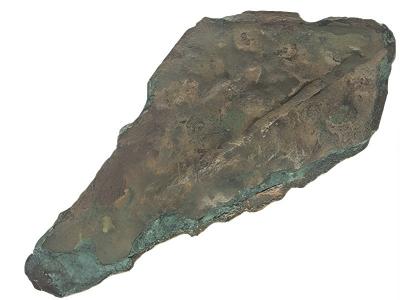Copper was one of the first metals discovered and used by humanity. The mining, smelting, and casting technologies of copper-based artifacts, best exemplified by bronze, have become a defining symbol of outstanding traditional Chinese culture. On November 25, the School of Archaeology and Cultural Heritage of Zhengzhou University released its latest findings in the Yangtze River basin. The two bronze wares, a bronze arrowhead and a bronze rod-shaped instrument, unearthed at the Gouwan site in Xichuan county of Nanyang city, Central China's Henan province, can be traced back approximately 4,500 years. This makes them the earliest known bronze artifacts ever unearthed in the Yangtze River basin, pushing the region's bronze-casting history back to the late Qujialing Culture period.
Both the two bronze wares were unearthed from the late Qujialing Culture layer. The bronze arrowhead is typical of those from the same period. It now measures 3.66 cm in length, featuring a flat cross-section and distinct casting marks. The bronze rod-shaped instrument is cylindrical in form, measuring 6.45 cm in length, with clearly visible casting holes. Both artifacts display clearly visible casting seams on their surfaces.

Bronze arrowhead
According to the team leader from the School of Archaeology and Cultural Heritage of Zhengzhou University, both artifacts were made from a Cu-Sn-Pb ternary alloy. The high levels of impurity elements, along with the loose and porous texture, suggest that the raw materials were directly smelted from multi-metal ores, reflecting the primitive nature of early metallurgical technology. The latest findings have been published in Archaeological Research in Asia, an international academic journal.
"As early representatives of China's bronze civilization, both the artifacts provide new material for studying the origin, spread, and development of metal-casting techniques." According to the team leader, while early bronze remains in China have mostly been found in the Northwest and North, the discovery of these two wares not only confirms that bronze-casting tools had already appeared in the Yangtze River basin during the late Qujialing Culture, but also pushes the casting history in the middle Yangtze River back some 4,500 years. This suggests that the casting history of the Yangtze River basin may have parallels with that of the North, providing valuable evidence for reexamining the multiple origins of China's early bronze civilization.

Bronze rod-shaped object
Located in Xichuan county, the Gouwan site was excavated by an archaeological team from Zhengzhou University between 2007 to 2009 to facilitate the construction of the Danjiangkou Reservoir, the source of the Middle Route of the South-to-North Water Diversion Project. At the site, a prehistoric settlement was discovered for the first time in the middle Hanshui River basin. In addition, remains reflecting the Central Plain cultures, including the Yangshao Culture and the third phase of Wangwan Culture, as well as cultures from the Yangtze and Hanshui Rivers, such as the Qujialing and Shijiahe Cultures, were also unearthed. These findings reflect interactions between China's northern and southern regions and provide valuable evidence for understanding the development of a diverse yet integrated civilization. The site was selected as one of Henan's Top 5 Archaeological Discoveries in 2008. (Chinese source: Henan Daily Reporter: Fan Xuejing Translator: Yang Jiaxin Proofreader: Jiao Dan and Zhao Hanqing)


